belt Hyundai Accent 2005 Owner's Manual
[x] Cancel search | Manufacturer: HYUNDAI, Model Year: 2005, Model line: Accent, Model: Hyundai Accent 2005Pages: 219, PDF Size: 7.07 MB
Page 6 of 219
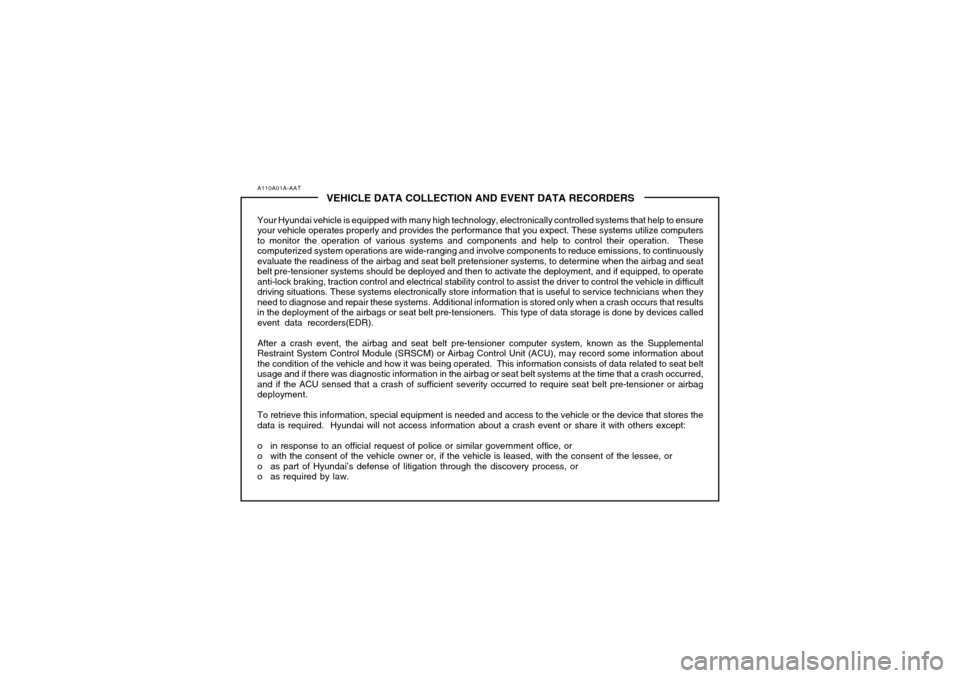
A110A01A-AAT
VEHICLE DATA COLLECTION AND EVENT DATA RECORDERS
Your Hyundai vehicle is equipped with many high technology, electronically controlled systems that help to ensure
your vehicle operates properly and provides the performance that you expect. These systems utilize computers
to monitor the operation of various systems and components and help to control their operation. These
computerized system operations are wide-ranging and involve components to reduce emissions, to continuously
evaluate the readiness of the airbag and seat belt pretensioner systems, to determine when the airbag and seat
belt pre-tensioner systems should be deployed and then to activate the deployment, and if equipped, to operate
anti-lock braking, traction control and electrical stability control to assist the driver to control the vehicle in difficult
driving situations. These systems electronically store information that is useful to service technicians when they
need to diagnose and repair these systems. Additional information is stored only when a crash occurs that results
in the deployment of the airbags or seat belt pre-tensioners. This type of data storage is done by devices called
event data recorders(EDR).
After a crash event, the airbag and seat belt pre-tensioner computer system, known as the Supplemental
Restraint System Control Module (SRSCM) or Airbag Control Unit (ACU), may record some information about
the condition of the vehicle and how it was being operated. This information consists of data related to seat belt
usage and if there was diagnostic information in the airbag or seat belt systems at the time that a crash occurred,
and if the ACU sensed that a crash of sufficient severity occurred to require seat belt pre-tensioner or airbag
deployment.
To retrieve this information, special equipment is needed and access to the vehicle or the device that stores the
data is required. Hyundai will not access information about a crash event or share it with others except:
o in response to an official request of police or similar government office, or
o with the consent of the vehicle owner or, if the vehicle is leased, with the consent of the lessee, or
o as part of Hyundai’s defense of litigation through the discovery process, or
o as required by law.
Page 12 of 219

YOUR VEHICLE AT A GLANCE
High Beam Indicator Light
Parking Brake/Low Brake Fluid Level
Warning LightDoor Ajar Warning Light
O/D OFF Indicator
(Automatic transaxle only)
B255A01A-AATINDICATOR SYMBOLS ON THE INSTRUMENT PANEL* More detailed explanations of these items will be found begining on page 1-38.
SRS (Airbag) Service Reminder
Indicator
ABS Service Reminder Indicator (If Installed)
Turn Signal Indicator Lights
Low Oil Pressure Warning LightCharging System Warning Light
Low Fuel Level Warning Light
Malfunction Indicator Light
Seat Belt Reminder Light
Trunk Lid / Tail Gate Open Warning Light
Page 13 of 219
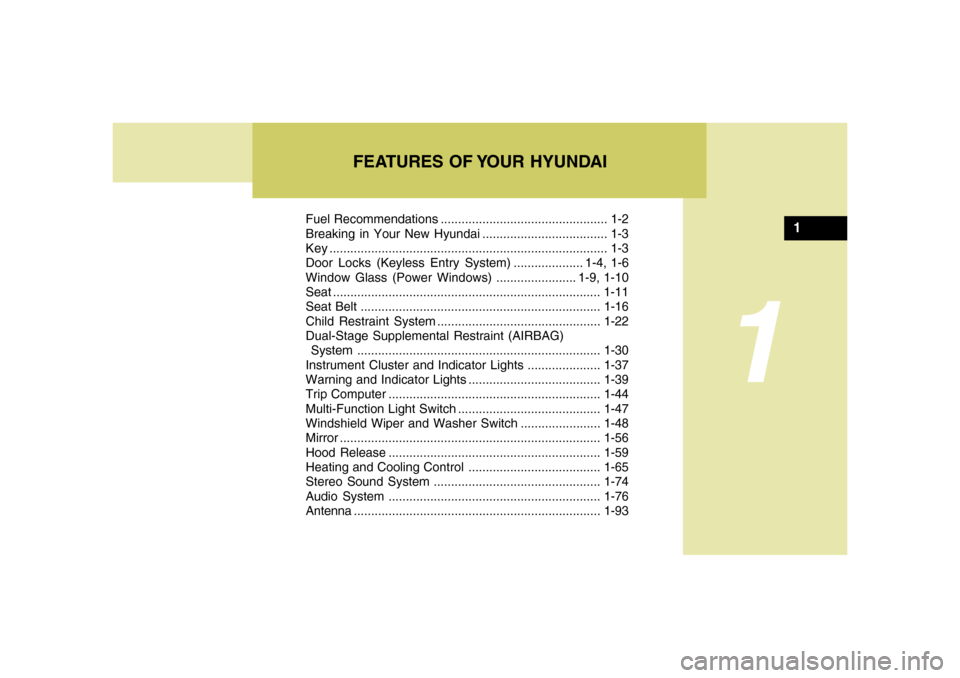
FEATURES OF YOUR HYUNDAI
1
Fuel Recommendations ................................................ 1-2
Breaking in Your New Hyundai .................................... 1-3
Key ................................................................................ 1-3
Door Locks (Keyless Entry System) .................... 1-4, 1-6
Window Glass (Power Windows) ....................... 1-9, 1-10
Seat ............................................................................. 1-11
Seat Belt.....................................................................1-16
Child Restraint System...............................................1-22
Dual-Stage Supplemental Restraint (AIRBAG)
System......................................................................1-30
Instrument Cluster and Indicator Lights .....................1-37
Warning and Indicator Lights ......................................1-39
Trip Computer.............................................................1-44
Multi-Function Light Switch .........................................1-47
Windshield Wiper and Washer Switch.......................1-48
Mirror...........................................................................1-56
Hood Release.............................................................1-59
Heating and Cooling Control ......................................1-65
Stereo Sound System................................................1-74
Audio System.............................................................1-76
Antenna.......................................................................1-93
1
Page 16 of 219
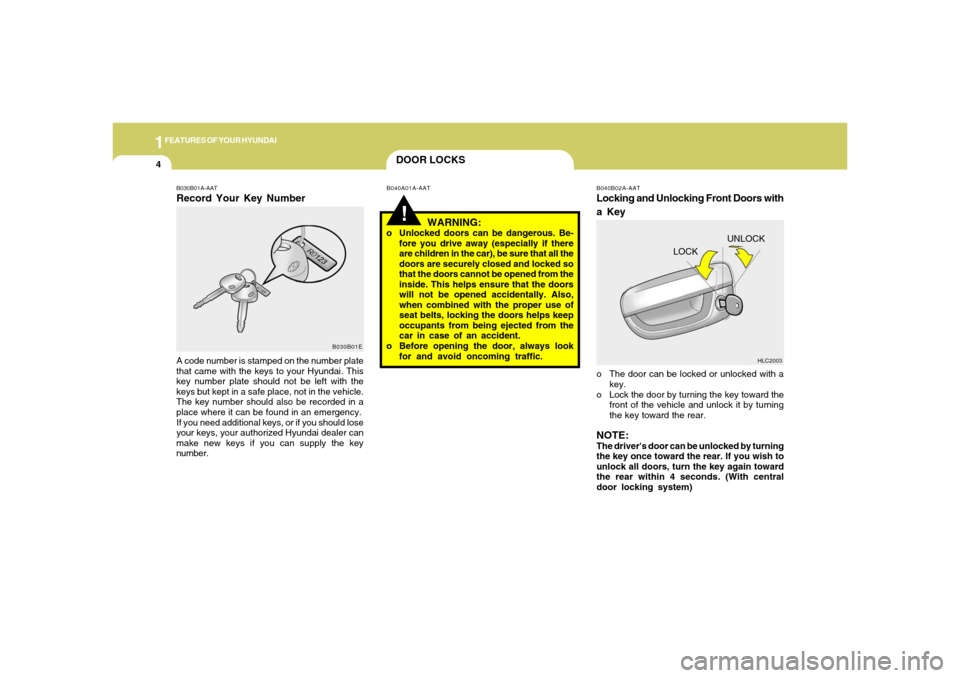
1FEATURES OF YOUR HYUNDAI4
DOOR LOCKS!
B030B01A-AATRecord Your Key NumberA code number is stamped on the number plate
that came with the keys to your Hyundai. This
key number plate should not be left with the
keys but kept in a safe place, not in the vehicle.
The key number should also be recorded in a
place where it can be found in an emergency.
If you need additional keys, or if you should lose
your keys, your authorized Hyundai dealer can
make new keys if you can supply the key
number.
B030B01EB040A01A-AAT B040B02A-AAT
Locking and Unlocking Front Doors with
a Keyo The door can be locked or unlocked with a
key.
o Lock the door by turning the key toward the
front of the vehicle and unlock it by turning
the key toward the rear.NOTE:The driver's door can be unlocked by turning
the key once toward the rear. If you wish to
unlock all doors, turn the key again toward
the rear within 4 seconds. (With central
door locking system)
WARNING:
o Unlocked doors can be dangerous. Be-
fore you drive away (especially if there
are children in the car), be sure that all the
doors are securely closed and locked so
that the doors cannot be opened from the
inside. This helps ensure that the doors
will not be opened accidentally. Also,
when combined with the proper use of
seat belts, locking the doors helps keep
occupants from being ejected from the
car in case of an accident.
o Before opening the door, always look
for and avoid oncoming traffic.UNLOCK
HLC2003
LOCK
Page 24 of 219
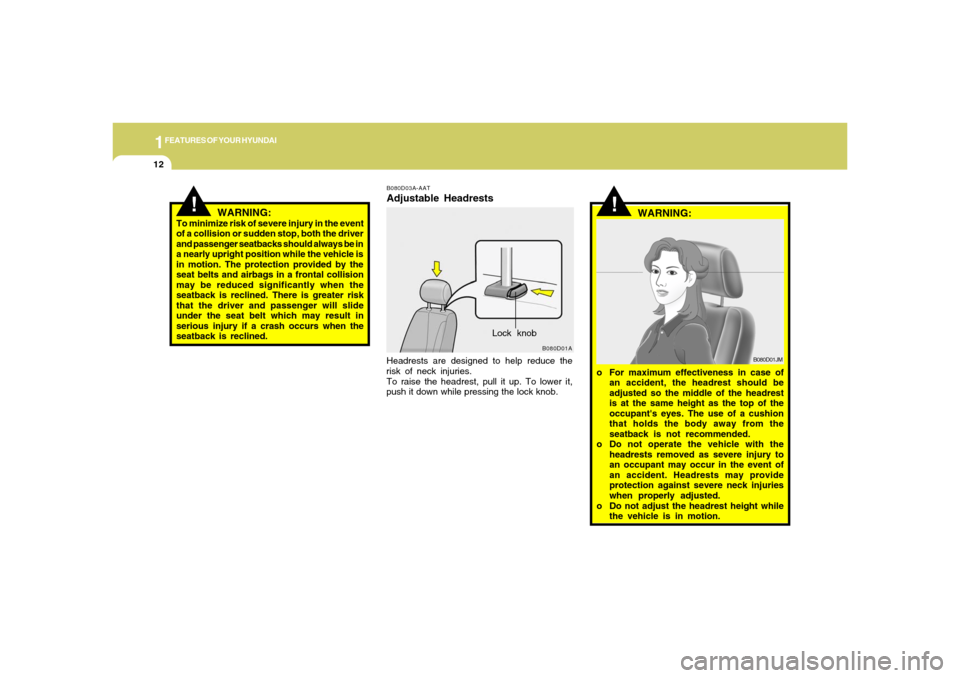
1FEATURES OF YOUR HYUNDAI12
!
!
B080D03A-AATAdjustable HeadrestsHeadrests are designed to help reduce the
risk of neck injuries.
To raise the headrest, pull it up. To lower it,
push it down while pressing the lock knob.
WARNING:
To minimize risk of severe injury in the event
of a collision or sudden stop, both the driver
and passenger seatbacks should always be in
a nearly upright position while the vehicle is
in motion. The protection provided by the
seat belts and airbags in a frontal collision
may be reduced significantly when the
seatback is reclined. There is greater risk
that the driver and passenger will slide
under the seat belt which may result in
serious injury if a crash occurs when the
seatback is reclined.
B080D01A
Lock knob
WARNING:
o For maximum effectiveness in case of
an accident, the headrest should be
adjusted so the middle of the headrest
is at the same height as the top of the
occupant's eyes. The use of a cushion
that holds the body away from the
seatback is not recommended.
o Do not operate the vehicle with the
headrests removed as severe injury to
an occupant may occur in the event of
an accident. Headrests may provide
protection against severe neck injuries
when properly adjusted.
o Do not adjust the headrest height while
the vehicle is in motion.
B080D01JM
Page 27 of 219
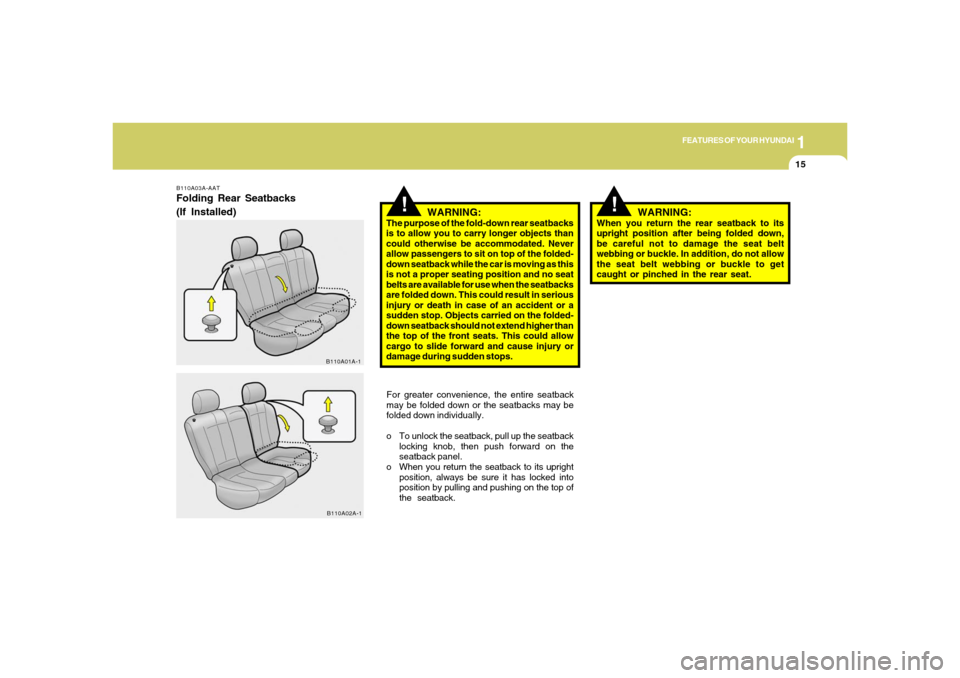
1
FEATURES OF YOUR HYUNDAI
15
!
!
WARNING:
The purpose of the fold-down rear seatbacks
is to allow you to carry longer objects than
could otherwise be accommodated. Never
allow passengers to sit on top of the folded-
down seatback while the car is moving as this
is not a proper seating position and no seat
belts are available for use when the seatbacks
are folded down. This could result in serious
injury or death in case of an accident or a
sudden stop. Objects carried on the folded-
down seatback should not extend higher than
the top of the front seats. This could allow
cargo to slide forward and cause injury or
damage during sudden stops.
For greater convenience, the entire seatback
may be folded down or the seatbacks may be
folded down individually.
o To unlock the seatback, pull up the seatback
locking knob, then push forward on the
seatback panel.
o When you return the seatback to its upright
position, always be sure it has locked into
position by pulling and pushing on the top of
the seatback.
B110A02A-1
WARNING:
When you return the rear seatback to its
upright position after being folded down,
be careful not to damage the seat belt
webbing or buckle. In addition, do not allow
the seat belt webbing or buckle to get
caught or pinched in the rear seat.
B110A03A-AATFolding Rear Seatbacks
(If Installed)
B110A01A-1
Page 28 of 219
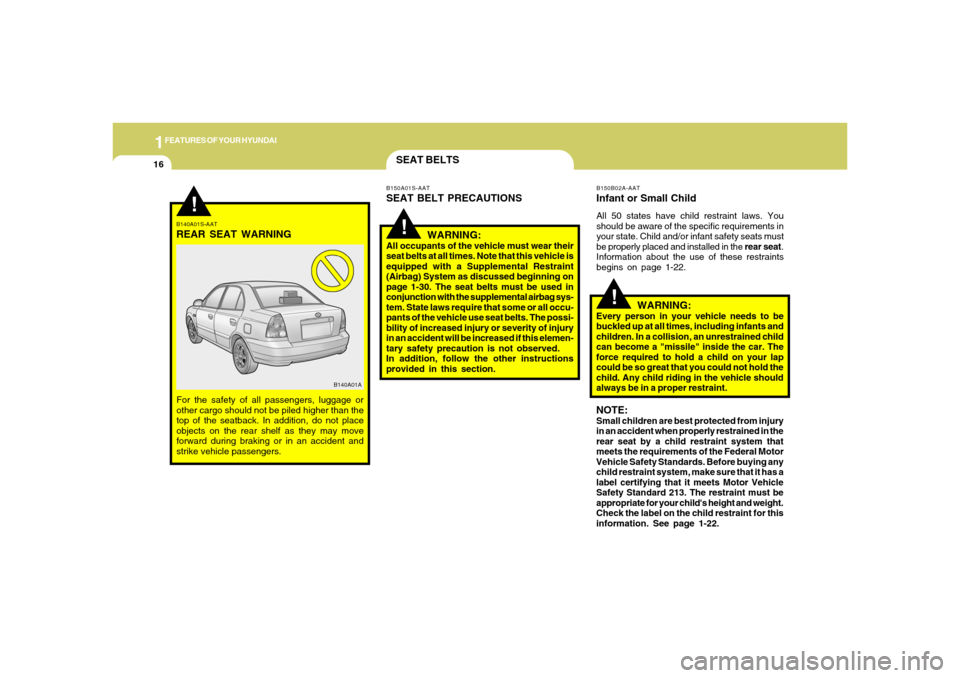
1FEATURES OF YOUR HYUNDAI16
SEAT BELTS
B140A01S-AATREAR SEAT WARNINGFor the safety of all passengers, luggage or
other cargo should not be piled higher than the
top of the seatback. In addition, do not place
objects on the rear shelf as they may move
forward during braking or in an accident and
strike vehicle passengers.
B140A01A
!
!
!
B150B02A-AATInfant or Small ChildAll 50 states have child restraint laws. You
should be aware of the specific requirements in
your state. Child and/or infant safety seats must
be properly placed and installed in the rear seat.
Information about the use of these restraints
begins on page 1-22.
B150A01S-AATSEAT BELT PRECAUTIONS
WARNING:All occupants of the vehicle must wear their
seat belts at all times. Note that this vehicle is
equipped with a Supplemental Restraint
(Airbag) System as discussed beginning on
page 1-30. The seat belts must be used in
conjunction with the supplemental airbag sys-
tem. State laws require that some or all occu-
pants of the vehicle use seat belts. The possi-
bility of increased injury or severity of injury
in an accident will be increased if this elemen-
tary safety precaution is not observed.
In addition, follow the other instructions
provided in this section.
WARNING:
Every person in your vehicle needs to be
buckled up at all times, including infants and
children. In a collision, an unrestrained child
can become a "missile" inside the car. The
force required to hold a child on your lap
could be so great that you could not hold the
child. Any child riding in the vehicle should
always be in a proper restraint.NOTE:Small children are best protected from injury
in an accident when properly restrained in the
rear seat by a child restraint system that
meets the requirements of the Federal Motor
Vehicle Safety Standards. Before buying any
child restraint system, make sure that it has a
label certifying that it meets Motor Vehicle
Safety Standard 213. The restraint must be
appropriate for your child's height and weight.
Check the label on the child restraint for this
information. See page 1-22.
Page 29 of 219
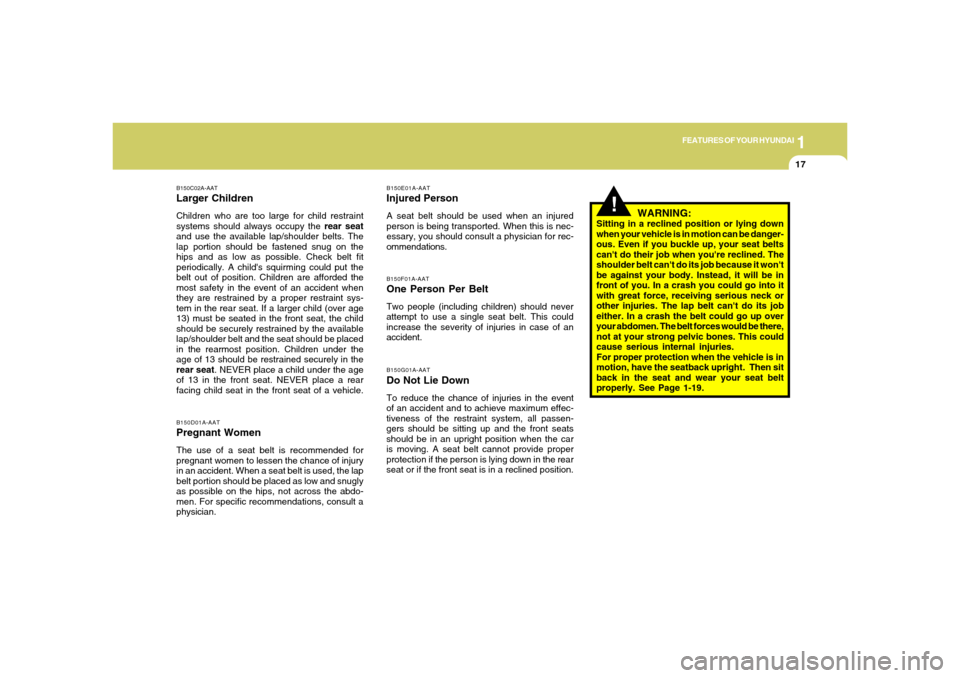
1
FEATURES OF YOUR HYUNDAI
17
!
B150E01A-AATInjured PersonA seat belt should be used when an injured
person is being transported. When this is nec-
essary, you should consult a physician for rec-
ommendations.B150F01A-AATOne Person Per BeltTwo people (including children) should never
attempt to use a single seat belt. This could
increase the severity of injuries in case of an
accident.B150G01A-AATDo Not Lie DownTo reduce the chance of injuries in the event
of an accident and to achieve maximum effec-
tiveness of the restraint system, all passen-
gers should be sitting up and the front seats
should be in an upright position when the car
is moving. A seat belt cannot provide proper
protection if the person is lying down in the rear
seat or if the front seat is in a reclined position.
WARNING:
Sitting in a reclined position or lying down
when your vehicle is in motion can be danger-
ous. Even if you buckle up, your seat belts
can't do their job when you're reclined. The
shoulder belt can't do its job because it won't
be against your body. Instead, it will be in
front of you. In a crash you could go into it
with great force, receiving serious neck or
other injuries. The lap belt can't do its job
either. In a crash the belt could go up over
your abdomen. The belt forces would be there,
not at your strong pelvic bones. This could
cause serious internal injuries.
For proper protection when the vehicle is in
motion, have the seatback upright. Then sit
back in the seat and wear your seat belt
properly. See Page 1-19.
B150D01A-AATPregnant WomenThe use of a seat belt is recommended for
pregnant women to lessen the chance of injury
in an accident. When a seat belt is used, the lap
belt portion should be placed as low and snugly
as possible on the hips, not across the abdo-
men. For specific recommendations, consult a
physician.B150C02A-AATLarger ChildrenChildren who are too large for child restraint
systems should always occupy the rear seat
and use the available lap/shoulder belts. The
lap portion should be fastened snug on the
hips and as low as possible. Check belt fit
periodically. A child's squirming could put the
belt out of position. Children are afforded the
most safety in the event of an accident when
they are restrained by a proper restraint sys-
tem in the rear seat. If a larger child (over age
13) must be seated in the front seat, the child
should be securely restrained by the available
lap/shoulder belt and the seat should be placed
in the rearmost position. Children under the
age of 13 should be restrained securely in the
rear seat. NEVER place a child under the age
of 13 in the front seat. NEVER place a rear
facing child seat in the front seat of a vehicle.
Page 30 of 219
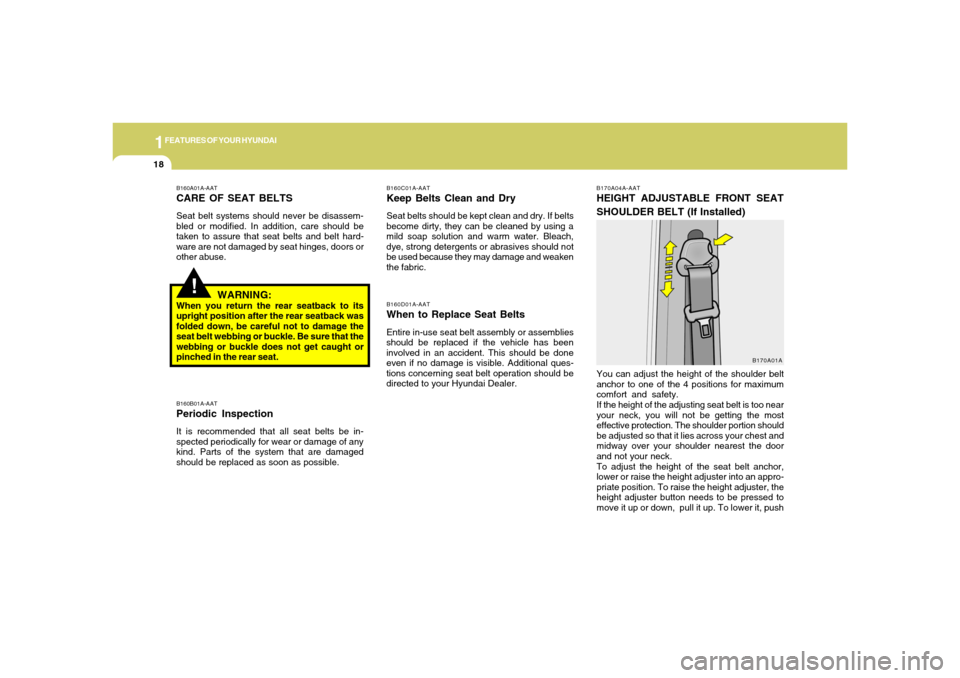
1FEATURES OF YOUR HYUNDAI18
!
B160A01A-AATCARE OF SEAT BELTSSeat belt systems should never be disassem-
bled or modified. In addition, care should be
taken to assure that seat belts and belt hard-
ware are not damaged by seat hinges, doors or
other abuse.B160B01A-AATPeriodic InspectionIt is recommended that all seat belts be in-
spected periodically for wear or damage of any
kind. Parts of the system that are damaged
should be replaced as soon as possible.
WARNING:
When you return the rear seatback to its
upright position after the rear seatback was
folded down, be careful not to damage the
seat belt webbing or buckle. Be sure that the
webbing or buckle does not get caught or
pinched in the rear seat.
B160D01A-AATWhen to Replace Seat BeltsEntire in-use seat belt assembly or assemblies
should be replaced if the vehicle has been
involved in an accident. This should be done
even if no damage is visible. Additional ques-
tions concerning seat belt operation should be
directed to your Hyundai Dealer.B160C01A-AATKeep Belts Clean and DrySeat belts should be kept clean and dry. If belts
become dirty, they can be cleaned by using a
mild soap solution and warm water. Bleach,
dye, strong detergents or abrasives should not
be used because they may damage and weaken
the fabric.
B170A04A-AATHEIGHT ADJUSTABLE FRONT SEAT
SHOULDER BELT (If Installed)
B170A01A
You can adjust the height of the shoulder belt
anchor to one of the 4 positions for maximum
comfort and safety.
If the height of the adjusting seat belt is too near
your neck, you will not be getting the most
effective protection. The shoulder portion should
be adjusted so that it lies across your chest and
midway over your shoulder nearest the door
and not your neck.
To adjust the height of the seat belt anchor,
lower or raise the height adjuster into an appro-
priate position. To raise the height adjuster, the
height adjuster button needs to be pressed to
move it up or down, pull it up. To lower it, push
Page 31 of 219
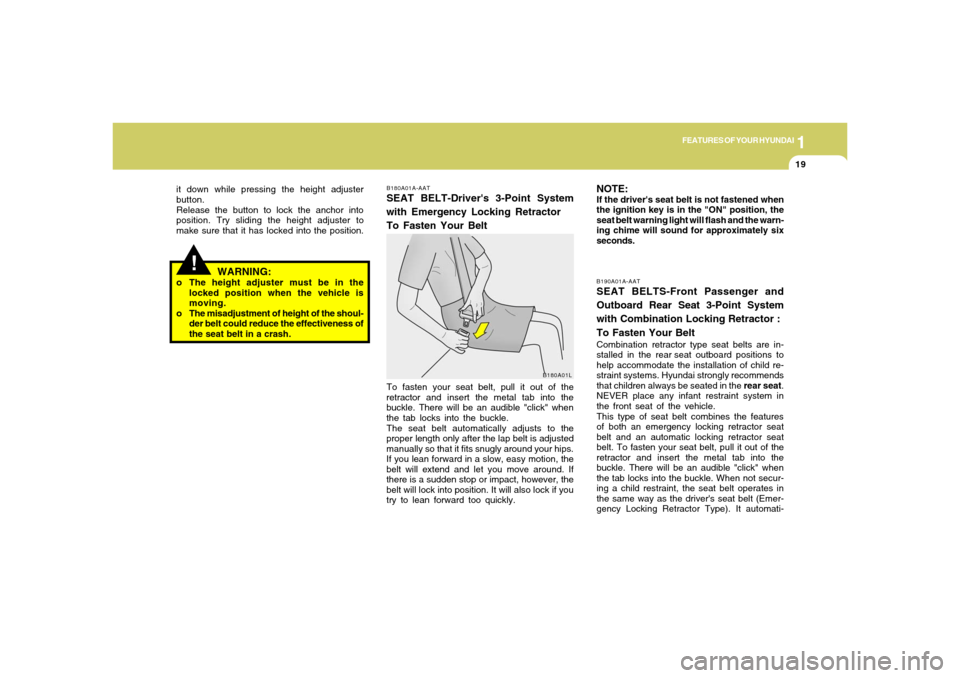
1
FEATURES OF YOUR HYUNDAI
19
To fasten your seat belt, pull it out of the
retractor and insert the metal tab into the
buckle. There will be an audible "click" when
the tab locks into the buckle.
The seat belt automatically adjusts to the
proper length only after the lap belt is adjusted
manually so that it fits snugly around your hips.
If you lean forward in a slow, easy motion, the
belt will extend and let you move around. If
there is a sudden stop or impact, however, the
belt will lock into position. It will also lock if you
try to lean forward too quickly.
B190A01A-AATSEAT BELTS-Front Passenger and
Outboard Rear Seat 3-Point System
with Combination Locking Retractor :
To Fasten Your BeltCombination retractor type seat belts are in-
stalled in the rear seat outboard positions to
help accommodate the installation of child re-
straint systems. Hyundai strongly recommends
that children always be seated in the rear seat.
NEVER place any infant restraint system in
the front seat of the vehicle.
This type of seat belt combines the features
of both an emergency locking retractor seat
belt and an automatic locking retractor seat
belt. To fasten your seat belt, pull it out of the
retractor and insert the metal tab into the
buckle. There will be an audible "click" when
the tab locks into the buckle. When not secur-
ing a child restraint, the seat belt operates in
the same way as the driver's seat belt (Emer-
gency Locking Retractor Type). It automati-
!
B180A01A-AATSEAT BELT-Driver's 3-Point System
with Emergency Locking Retractor
To Fasten Your Belt
WARNING:
o The height adjuster must be in the
locked position when the vehicle is
moving.
o The misadjustment of height of the shoul-
der belt could reduce the effectiveness of
the seat belt in a crash.
B180A01L
it down while pressing the height adjuster
button.
Release the button to lock the anchor into
position. Try sliding the height adjuster to
make sure that it has locked into the position.
NOTE:If the driver's seat belt is not fastened when
the ignition key is in the "ON" position, the
seat belt warning light will flash and the warn-
ing chime will sound for approximately six
seconds.